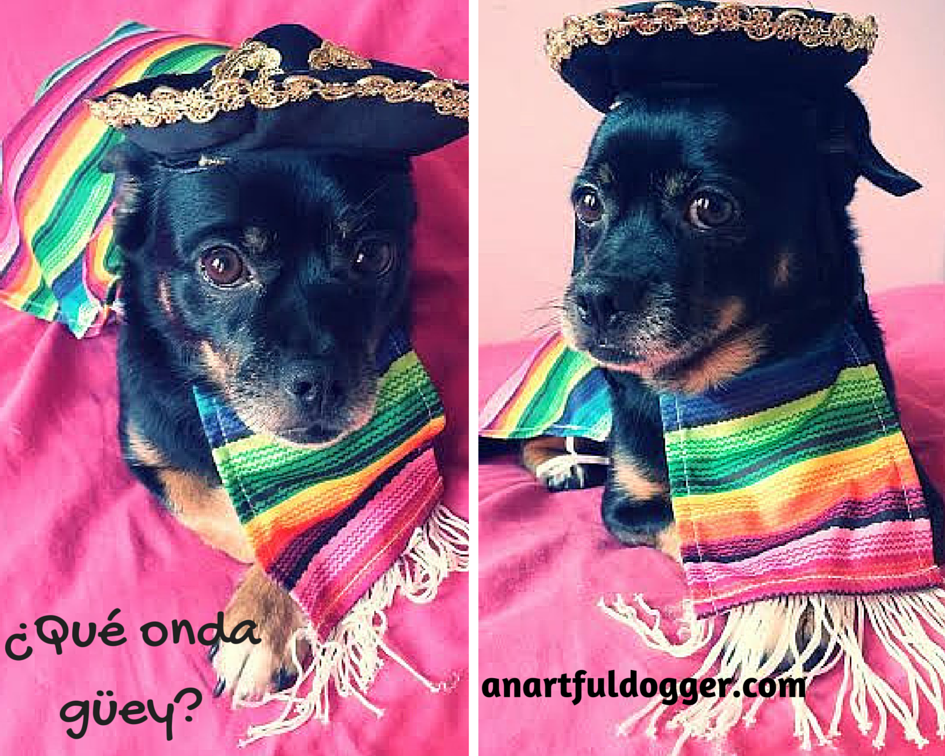Contents
- 1 Doxielogy: Praise Dog!
- 2 ¡Ay, Chihuahua! Tacos y salchichas. ¡Dios mío! (Tacos and Sausages, Oh My!)
- 3 Eek! They Don’t End in an S!
- 4 Corgi Porgi
- 5 Lab(rad)or of Love
- 6 Oh, Great! It’s the Great Dane!
- 7 How Great (and Tiny!) Thou Art
- 8 Top Dog or Down Dog? UPPER CASE or lower case?
- 9 It’s a Dogma-Eat-Karma World!
- 10 The Cattail End

Pico “Piccolo” declares and celebrates the Chiweenie Heritage Month.
I enjoy a great deal of cross-cultural, linguistic, and literary geekery, especially when paired with the animal kingdom.
That said, I’ve compiled a few fun facts on that intersection. Impress your fellow critter lovers with this trivia list of artful doggery!
Doxielogy: Praise Dog!
Did you know that the Dachshund is normally called Dackel in Germany and Teckel (the hunting variety) around the globe? The wirehaired variety is also referred to as Teckel. French and Spanish speakers also prefer the general term Teckel for both working and non-working types.
¡Ay, Chihuahua! Tacos y salchichas. ¡Dios mío! (Tacos and Sausages, Oh My!)
Long before the Chiweenie became one of the most popular designer breeds, Germans and Mexicans had already created hybrids in the forms of music and feast. Did you know that one of Oktoberfest celebrations in Mexico was held in the state of Chihuahua?
As for that lovable little breed, Spanish speakers refer to it as chihuahua, or more commonly, chihuahueño.
Eek! They Don’t End in an S!
Plurals of breeds, including the viszla, puli, and komondor, are usually Anglicized, but the correct Hungarian forms are viszlak, pulik, and komondorok, respectively.
Corgi Porgi
It’s commonly thought that corgi is derived from cor + ci (gi), Welsh for “dwarf dog.” Ci mutates into gi through lenition, weakening or softening of consonants into vowel-like sounds.
However, Clifford L. B. Hubbard maintained that corgi was better translated as cur dog with the proper plural form of corgwn (pronounced cor-goon).
As an aside, a porgy is a literally different kettle of fish, of course, since it’s a species in the Mediterranean and on the Atlantic coasts of Europe and America!
Lab(rad)or of Love
The breed’s true origin is Newfoundland, just like the island’s canine namesake. Labrador is located just northwest of Newfoundland. The name Labrador, attributed to Portuguese explorer João Fernandes, is derived from the Portuguese lavrador and Spanish labrador, meaning laborer. It’s a very fitting name for this hard-working breed!
Oh, Great! It’s the Great Dane!
Here’s a breed that’s all over the European geographic and linguistic map.
Known as boar hounds, they were called English dogges (Englische Doggen) after the 16th century. Then the Germans bred them to be indoor guards, hence the name Kammerhunde (chamber dog).
During his travels in Denmark, the French naturalist Comte de Buffon coined the name grand danois, the Great Danish dog, seeing what the Danish climate did to the greyhound. At the time, the French called it dogue allemand (German mastiff). The Danish attribution stuck, though Denmark had nothing to do with the development of the breed.
Interestingly, the Germans partially Anglicize the breed’s current name, Deutsche Dogge.
How Great (and Tiny!) Thou Art
Believe it or not, thou is still used in some parts of England, particularly Yorkshire—yes, the home base of that spunky toy terrier breed big on attitude! Some spellings and pronunciations have been altered in contemporary regional speech. Example: tha nowse (thou knowest).
The use of the formal you gradually replaced the informal thou as the social climbers in the 17th and 18th centuries aspired to be part of the crème de la crème of British society.
Believing in a classless, egalitarian society, the Quakers also normally used thou among themselves, but this is no longer common practice except in family interactions.
Top Dog or Down Dog? UPPER CASE or lower case?
It’s commonly thought that dog breeds are normally capitalized, but the basic rule is that the parts derived from proper nouns are capitalized while everything else is in lower case.
The AKC adheres to the convention of capitalization. As a stylistic preference, I use the upper case if it’s also called for in the original language. Example: Dachshund. In German, all nouns are capitalized.
It’s a Dogma-Eat-Karma World!
The Canine in Conversation is a vast interdisciplinary compilation of dog-themed English idiomatic expressions and their social, cultural, and linguistic narratives. This is the place to get geeked out!
The Cattail End
Unfortunately, for our purring furry friends, I can’t seem to find many cool linguistic tidbits—other than the oh-so-run-of-the-mill “it’s raining cats and dogs”! However, there’s the catbird seat: a position of prominence or advantage. So much for the top dog when cats top ’em all!
A feline-monikered plant marks the end of this post: cattail, named after its resemblance to its namesake at flowering maturity. Interestingly, one of the nicknames for cattail is corn dog grass, probably because it looks just like that particular edible!


